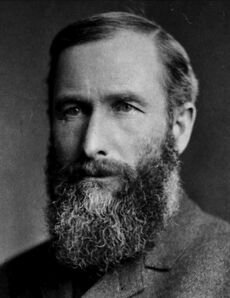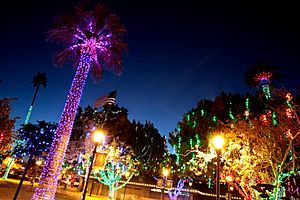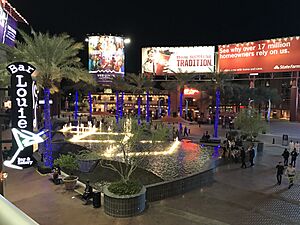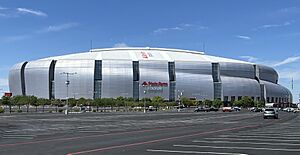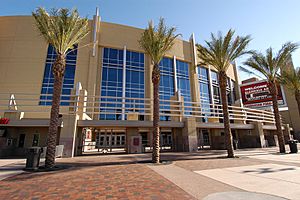Glendale, Arizona facts for kids
Quick facts for kids
Glendale
|
|||
|---|---|---|---|
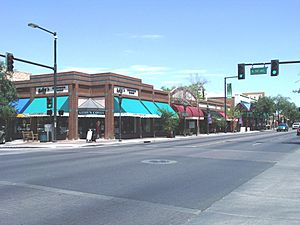
Downtown Glendale
|
|||
|
|||
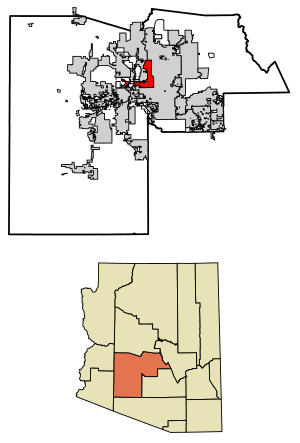
Location in Maricopa County, Arizona
|
|||
| Country | United States | ||
| State | Arizona | ||
| County | Maricopa | ||
| Founded by | William John Murphy | ||
| Area | |||
| • Total | 65.09 sq mi (168.59 km2) | ||
| • Land | 64.68 sq mi (167.53 km2) | ||
| • Water | 0.41 sq mi (1.06 km2) | ||
| Elevation | 1,152 ft (351 m) | ||
| Population
(2020)
|
|||
| • Total | 248,325 | ||
| • Rank | US: 89th | ||
| • Density | 3,839.17/sq mi (1,482.30/km2) | ||
| Demonym(s) | Glendalian | ||
| Time zone | UTC−7 (MST (no DST)) | ||
| ZIP code |
85301-85312 & 85318
|
||
| Area codes | 602, 480, 623 | ||
| FIPS code | 04-27820 | ||
| GNIS feature ID | 5060 | ||
Glendale is a city in Maricopa County, Arizona, United States. It is located about nine miles northwest of Phoenix, the state capital. Glendale is famous for State Farm Stadium, which is the home of the Arizona Cardinals football team. The city also has the Arrowhead Towne Center shopping mall. In 2020, Glendale had a population of 248,325 people.
Contents
History of Glendale
In the late 1800s, the area that is now Glendale was mostly desert. William John Murphy, who lived in Flagstaff, was in charge of building the 40-mile-long Arizona Canal. This canal was built to bring water to the dry desert land. Murphy finished the canal in 1885.
In 1887, Murphy started the Arizona Improvement Company. His goal was to sell the land and water rights south of the canal. Murphy decided to call this new area "Glendale." To help people get to Glendale, he built an 18-mile road called Grand Avenue. This road connected Phoenix to Glendale and ended in Peoria.
In 1891, Murphy worked with Burgess Hadsell to bring 70 families to Glendale. These families wanted to create a community that did not allow alcohol. More settlers came to Glendale because of this rule. In 1895, Murphy planned the town, adding a park and business areas. A railroad was also built from Prescott to Phoenix. This made it easier for Glendale settlers to transport goods and get building materials.
The Beet Sugar Factory opened in 1906 and helped Glendale grow. Even though it only operated until 1913, it brought many new settlers to the city. Other businesses like Glendale Ice Company and Pacific Creamery Company also started around this time.
Glendale During World Wars
During World War I, Glendale's economy grew because cotton prices went up. Cotton farming continued to be important, even though some farmers switched to other crops. There was also a high demand for food, which kept farmers busy. Many farms and orchards did well in the early 1900s.
World War II brought Thunderbird Field to Glendale. This field was used to train civilian pilots for the Army. Hollywood actors helped set up this flight school in 1940. They chose Glendale because it had lots of space, good weather, and clear skies. In 1941, a larger base called Luke Field (now Luke Air Force Base) was also built nearby. Thunderbird Field later became the Thunderbird School of Global Management.
Modern Growth and Development
After the wars, Glendale's population grew a lot, almost doubling between 1950 and 1960. This led to a need for more services like utilities, parks, schools, and streets. Over the next 40 years, the city added a landfill, water treatment plants, libraries, and public safety buildings.
In 1993, the Arrowhead Towne Center mall opened. The area around it, Arrowhead Ranch, became a popular place for homes and shopping. The completion of Loop 101 helped connect Glendale to the rest of the Valley.
In recent years, Glendale has invested a lot in tourism. The Westgate Entertainment District, which includes Desert Diamond Arena and State Farm Stadium, opened in the early 2000s. This made Glendale a popular spot for visitors. New projects like the VAI Resort and Mattel Adventure Park (opening in 2025) are expected to bring even more tourists and jobs. The completion of Loop 303 in 2011 also led to more industrial development.
Glendale's Geography and Climate
Glendale covers about 65.1 square miles. A small part of this area, about 0.4 square miles, is water. The New River and Agua Fria River flow through the western parts of the city.
Glendale's Climate
Glendale has a hot desert climate, which is common in Southern Arizona. Summers are very hot and dry, while winters are mild.
| Climate data for Phoenix Int'l, Arizona (1981–2010 normals, extremes 1895–present) | |||||||||||||
|---|---|---|---|---|---|---|---|---|---|---|---|---|---|
| Month | Jan | Feb | Mar | Apr | May | Jun | Jul | Aug | Sep | Oct | Nov | Dec | Year |
| Record high °F (°C) | 88 (31) |
92 (33) |
100 (38) |
105 (41) |
114 (46) |
122 (50) |
121 (49) |
117 (47) |
116 (47) |
107 (42) |
96 (36) |
87 (31) |
122 (50) |
| Mean maximum °F (°C) | 78.7 (25.9) |
82.8 (28.2) |
90.0 (32.2) |
98.6 (37.0) |
105.9 (41.1) |
112.5 (44.7) |
114.4 (45.8) |
112.5 (44.7) |
108.6 (42.6) |
100.1 (37.8) |
88.1 (31.2) |
77.1 (25.1) |
115.2 (46.2) |
| Mean daily maximum °F (°C) | 67.2 (19.6) |
70.7 (21.5) |
76.9 (24.9) |
85.2 (29.6) |
94.8 (34.9) |
103.9 (39.9) |
106.1 (41.2) |
104.4 (40.2) |
99.8 (37.7) |
88.5 (31.4) |
75.5 (24.2) |
66.0 (18.9) |
86.6 (30.3) |
| Daily mean °F (°C) | 56.4 (13.6) |
59.7 (15.4) |
65.2 (18.4) |
72.7 (22.6) |
82.1 (27.8) |
90.8 (32.7) |
94.8 (34.9) |
93.6 (34.2) |
88.4 (31.3) |
76.7 (24.8) |
64.1 (17.8) |
55.4 (13.0) |
75.1 (23.9) |
| Mean daily minimum °F (°C) | 45.6 (7.6) |
48.7 (9.3) |
53.5 (11.9) |
60.2 (15.7) |
69.4 (20.8) |
77.7 (25.4) |
83.5 (28.6) |
82.7 (28.2) |
76.9 (24.9) |
64.8 (18.2) |
52.7 (11.5) |
44.8 (7.1) |
63.4 (17.4) |
| Mean minimum °F (°C) | 36.2 (2.3) |
39.4 (4.1) |
43.2 (6.2) |
49.5 (9.7) |
58.0 (14.4) |
68.4 (20.2) |
73.7 (23.2) |
73.7 (23.2) |
67.1 (19.5) |
53.6 (12.0) |
40.8 (4.9) |
34.6 (1.4) |
33.5 (0.8) |
| Record low °F (°C) | 16 (−9) |
24 (−4) |
25 (−4) |
35 (2) |
39 (4) |
49 (9) |
63 (17) |
58 (14) |
47 (8) |
34 (1) |
27 (−3) |
22 (−6) |
16 (−9) |
| Average precipitation inches (mm) | 0.91 (23) |
0.92 (23) |
0.99 (25) |
0.28 (7.1) |
0.11 (2.8) |
0.02 (0.51) |
1.05 (27) |
1.00 (25) |
0.64 (16) |
0.58 (15) |
0.65 (17) |
0.88 (22) |
8.03 (204) |
| Average precipitation days (≥ 0.01 in) | 4.1 | 4.4 | 3.9 | 1.7 | 1.0 | 0.5 | 4.2 | 5.0 | 2.8 | 2.5 | 2.6 | 3.9 | 36.6 |
| Average relative humidity (%) | 50.9 | 44.4 | 39.3 | 27.8 | 21.9 | 19.4 | 31.6 | 36.2 | 35.6 | 36.9 | 43.8 | 51.8 | 36.6 |
| Mean monthly sunshine hours | 256.0 | 257.2 | 318.4 | 353.6 | 401.0 | 407.8 | 378.5 | 360.8 | 328.6 | 308.9 | 256.0 | 244.8 | 3,871.6 |
| Percent possible sunshine | 81 | 84 | 86 | 90 | 93 | 95 | 86 | 87 | 89 | 88 | 82 | 79 | 87 |
| Source: NOAA (relative humidity and sun 1961–1990) , Weather.com | |||||||||||||
Glendale's Population
| Historical population | |||
|---|---|---|---|
| Census | Pop. | %± | |
| 1910 | 1,000 | — | |
| 1920 | 2,737 | 173.7% | |
| 1930 | 3,665 | 33.9% | |
| 1940 | 4,855 | 32.5% | |
| 1950 | 8,179 | 68.5% | |
| 1960 | 15,893 | 94.3% | |
| 1970 | 36,228 | 127.9% | |
| 1980 | 97,172 | 168.2% | |
| 1990 | 147,864 | 52.2% | |
| 2000 | 218,812 | 48.0% | |
| 2010 | 226,721 | 3.6% | |
| 2020 | 248,325 | 9.5% | |
| U.S. Decennial Census | |||
Population in 2020
The 2020 United States census counted 248,325 people living in Glendale. There were 86,483 households and 59,565 families. The population density was about 4,031 people per square mile.
About 25.3% of the population was under 18 years old. The average age in Glendale was 34.5 years. The median household income was about $56,991. About 17.2% of the population lived below the poverty line.
Economy and Jobs in Glendale
Glendale has many different types of jobs. Here are some of the top employers in the city:
| # | Employer | # of Employees |
|---|---|---|
| 1 | Luke Air Force Base | 5,100 |
| 2 | Banner Health | 3,000 |
| 3 | Arrowhead Towne Center | 2,650 |
| 4 | Walmart | 2,175 |
| 5 | Glendale Union High School District | 1,974 |
| 6 | Glendale Community College | 1,948 |
| 7 | The City of Glendale | 1,693 |
| 8 | Deer Valley Unified School District | 1,594 |
| 9 | Glendale Elementary School District | 1,400 |
| 10 | Tanger Outlets | 1,200 |
Arts, Culture, and Fun in Glendale
Glendale offers many attractions and events for residents and visitors.
Popular Attractions
- Adobe Mountain Desert Park
- Cerreta Candy Co. factory tours
- Camelback Ranch (spring training baseball)
- Desert Diamond Arena (sports and concerts)
- Mattel Adventure Park (opening in 2025)
- Sahuaro Ranch (historic park)
- State Farm Stadium (home of the Arizona Cardinals)
- Westgate Entertainment District (shopping, dining, entertainment)
Shopping in Glendale
Glendale is well-known for its shops that sell antiques. The Arrowhead Towne Center mall is also a major shopping destination in the city.
Concerts and Events
Glendale is a popular place for big concerts and events. For example, in March 2023, the city was temporarily called Swift City. This was to celebrate the start of Taylor Swift's Eras Tour at State Farm Stadium. The Westgate Entertainment District also had special messages and Swift-themed food. State Farm Stadium also hosted the Super Bowl LVII halftime show with Rihanna shortly before the tour.
Sports in Glendale
Glendale has two major sports venues: State Farm Stadium and Desert Diamond Arena. Both are part of the Glendale Sports and Entertainment District.
State Farm Stadium has been the home of the Arizona Cardinals football team since 2006. It also hosts the annual Fiesta Bowl college football game. The stadium has hosted three Super Bowls and college football national championship games. It also hosted the NCAA Men's Basketball Final Four and WrestleMania XXVI. The stadium is famous for its natural grass field that can roll in and out.
Desert Diamond Arena is next to State Farm Stadium. It used to be the home of the Arizona Coyotes hockey team. Now, it hosts the Arizona Rattlers of the Indoor Football League. It also hosts the annual Street League Skateboarding event.
In 2009, the Los Angeles Dodgers and Chicago White Sox baseball teams started sharing the new Camelback Ranch-Glendale complex for spring training.
Education in Glendale
Glendale has many schools and colleges.
Colleges and Universities
- Glendale Community College is part of the Maricopa County Community College District.
- Arizona State University’s Thunderbird School of Global Management is located in downtown Phoenix, but it started in Glendale after World War II.
- Midwestern University is a graduate college for medicine in Glendale.
School Districts
Many school districts serve the city of Glendale, including:
- Unified school districts: Deer Valley Unified School District, Dysart Unified School District, Peoria Unified School District (headquartered in Glendale).
- High school districts: Glendale Union High School District, Phoenix Union High School District, Tolleson Union High School District.
- Elementary school districts: Alhambra Elementary School District, Glendale Elementary School District, Pendergast Elementary School District, Washington Elementary School District.
There are also private schools like Grace Lutheran School, Our Lady of Perpetual Help Catholic School, and Arrowhead Christian Academy. New Gains Academy is a microschool for grades 5-12.
Transportation and Utilities
Getting Around Glendale
Most households in Glendale have cars. In 2016, the average household had 1.72 cars.
Glendale Municipal Airport serves the city, but it does not have commercial flights. The closest airport for commercial travel is Phoenix Sky Harbor International Airport, which is about 30 minutes away by car.
Major Highways
 Loop 101 (Agua Fria Freeway)
Loop 101 (Agua Fria Freeway) Loop 303 (Estrella Freeway)
Loop 303 (Estrella Freeway)- Northern Parkway (Northern Freeway)
 US-60 (Grand Avenue)
US-60 (Grand Avenue)
City Services
Glendale manages its own drinking water system for most of the city. EPCOR handles water in the Loop 303 area. Electricity is provided by Arizona Public Service and Salt River Project. The city also manages irrigation water in older areas.
Famous People from Glendale
- Prince Amukamara, professional football player
- Eddie Bonine, professional baseball player
- Elijah Burke, professional wrestler
- Jordan Capri, model
- Danny Cruz, professional soccer player
- Nick Evans, professional baseball player
- Trent Franks, former United States congressman
- Lauren Froderman, winner of So You Think You Can Dance
- Jennie Garth, actress
- Claire Kretzschmar, ballet dancer
- Paul LoDuca, professional baseball player
- Craig Mabbitt, lead singer of Escape the Fate
- Michael McDowell, NASCAR driver
- Evan Mecham, former Arizona governor
- Lou Novikoff, professional baseball player
- Jonathan Ornelas, baseball player
- Sterling Ridge, Arizona legislator
- Marty Robbins, Grammy-winning country musician
- Nate Ruess, lead singer of Fun
- Tage Thompson, NHL player
- Rickson van Hees, American soccer player
- Jason Zumwalt, actor
Sister Cities
Glendale has two sister cities, which are cities in other countries that have a special partnership:
 – Ørland, Norway
– Ørland, Norway – Memmingen, Germany
– Memmingen, Germany
See also
 In Spanish: Glendale (Arizona) para niños
In Spanish: Glendale (Arizona) para niños
- List of historic properties in Glendale, Arizona
- USS Arizona salvaged artifacts
- List of people from Phoenix
- Glendale Memorial Park Cemetery







